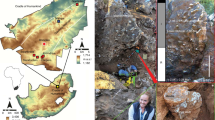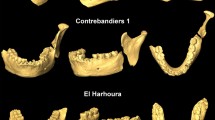Abstract
IN looking back over the history of the research on early man in China, it is of interest to realize how precarious was the adventure we entered upon. At the present time, we have five more or less complete skulls, four large skull-fragments, twelve mandibles, and nearly one hundred isolated teeth—indeed an imposing sum of specimens of Sinanthropus. However, the impressive point in this history is the fact that the vital generic characteristics of the distinct hominid were deduced from a diagnosis based, not upon this large number of specimens, but upon one single molar tooth. This specimen, which heralded a period of great scientific activity, was placed at our disposal in 1927 by the late Dr. Davidson Black.
This is a preview of subscription content, access via your institution
Access options
Subscribe to this journal
Receive 51 print issues and online access
$199.00 per year
only $3.90 per issue
Buy this article
- Purchase on Springer Link
- Instant access to full article PDF
Prices may be subject to local taxes which are calculated during checkout
Similar content being viewed by others
Author information
Authors and Affiliations
Rights and permissions
About this article
Cite this article
PEI, W. Sir Grafton Elliot Smith and Work on Early Man in China. Nature 139, 192–193 (1937). https://doi.org/10.1038/139192b0
Issue Date:
DOI: https://doi.org/10.1038/139192b0
Comments
By submitting a comment you agree to abide by our Terms and Community Guidelines. If you find something abusive or that does not comply with our terms or guidelines please flag it as inappropriate.



